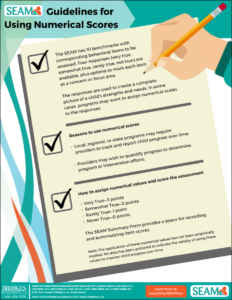Using SEAM with Families
Tips for introducing, scoring, sharing, and following up
A tool from the ASQ® developer group, Social-Emotional Assessment/Evaluation Measure (SEAM™) gives parents and practitioners a framework for examining children’s social-emotional development, and noting strengths and areas of concern.

There’s even a Family Profile portion for caregivers to report strengths and any additional support or resources they may need to provide the best environment for their child’s social and emotional growth.
SEAM can be a valuable addition to any early childhood program’s assessment toolbox, especially if you follow these tips for using the tool with families.
Introducing SEAM Family Profile
Following up with goals and activities
Introducing SEAM
Introducing SEAM to families in the right way can really help families engage productively with the process. Caregivers may need time before they feel comfortable sharing concerns and discussing issues about their child, so consider these best practices:
TIP: Build trust. If possible, try to have a few interactions with the family before asking caregivers to help complete SEAM or SEAM Family Profile.
TIP: Communicate SEAM’s purpose. If parents understand how the tool can benefit their child, they are likelier to appreciate the purpose of the questions and get engaged in the process. Not sure how to introduce SEAM? Try this:
“SEAM is a tool that helps us take a look at your child’s social-emotional development. Items on SEAM focus on skills children need in order to get along well with others, control their own emotions and behaviors, and develop a positive self-image. SEAM can help us identify specific skills and behaviors we can work on with your child, and it can also help us find resources to support your child’s social-emotional development. Positive social-emotional skills help children to be successful in all areas of their lives.”
TIP: Recognize caregiver differences. Not everyone will feel the same level of comfort or candidness. Keep in mind that a person’s individual culture, values, parenting style, and other characteristics or may affect how they respond to the process, and to the assessment items. Get to know them, ask questions, and be open-minded.
Introducing SEAM Family Profile
Like SEAM, SEAM Family Profile includes benchmarks and corresponding items for each of three intervals: infant, toddler, and preschool. But the Family Profile is designed to gather information about the strengths and needs of the caregiver as it relates to their child’s social-emotional development.
Not all programs that use SEAM also use SEAM Family Profile, but those that do find that it promotes parental engagement. SEAM co-developer Jane Squires, Ph.D., says, “it’s is an excellent tool for gathering a family’s view of their child, their own abilities with the child, and the areas of concern as well as joy.”
She adds that even though programs and individualized family service plan (IFSP) development may not require this information, families often like providing it. “They are very positive about having the opportunity to discuss the questions with providers and to have a conversation around their perceived strengths and areas in which they feel they need support.”
Here are some ways you can help get the most out of SEAM Family Profile:
TIP: Explain why the tool is valuable. Some caregivers may be uncomfortable talking about their parenting skills. Ease them into it by discussing the benefits of SEAM. You might say something like:
“SEAM Family Profile is designed to gather information about what you feel is going well in your relationship with your child as well as any supports and resources you might need to provide a safe and nurturing environment for your child. Items on SEAM Family Profile focus on knowledge, skills, and resources caregivers need in order to foster their children’s social-emotional development.”
TIP: Administer it in a way that works best for the caregiver. This may mean they complete it independently, or during parenting groups or classes, or in an interview setting. Even though items are written in language that is easy to understand, most practitioners prefer to offer an interview because it allows for real-time interaction with families.
Scoring SEAM
Sheila Zickefoose, an independent practitioner who works in the WV Birth to Three system (Part C), uses SEAM to assess kids who demonstrate risk factors, or whose ASQ®:SE-2 scores indicate a need. She finds that a vast majority of her families respond positively and are pleased to better understand what their child is experiencing. However, the process itself can still be challenging.
“For some families, it takes a great deal support to help them to understand the questions…and those issues can lead to increased time to facilitate the conversation,” Zickefoose says. She explains that the issue isn’t how the questions themselves are written, but that different families have different needs.
Zickefoose’s experience is common among practitioners, who find that the more time they invest in explaining how the assessment works, the more smoothly it goes. These tips may help:
|
Free Download! |
TIP: Review the scoring method. Before a caregiver completes SEAM, show them how it works. Explain the four possible responses (very true, somewhat true, rarely true, and never true) and how numerical values are assigned to each response, if these are being used. Download SEAM Guidelines for Using Numerical Scores tip sheet.
TIP: Encourage thoughtful responses. Tell caregivers to take their time and observe their child if needed, before responding to an item. Remind them that the examples are there just to give an idea of how a behavior might look and that every child is different.
TIP: Explain how to report concerns. For each item, have parents check the circle in the “Concern” column if they want to discuss it further. Make sure to follow up!
TIP: Explain how to highlight focus areas. Have them check the triangle in the “Focus Areas” column if they want more info, support, resources, or for that item to become an intervention goal. Again, follow up.
Sharing results
After SEAM and SEAM Family Profile are complete, and you’ve resolved any questions or inconsistencies, you may use the SEAM Summary Form to record information gathered from both portions. For the assessment, you can include numerical scores (if using), and whether items are strengths, concerns, or focus areas. For the Family Profile, you can note whether items are family strengths, agreed-upon focus areas, or if they want more information.
Nancy Miller is an early childhood student services consultant in the Early Childhood/Early Childhood Special Education program in the Blue Valley School District in Overland Park, Kansas. Blue Valley early childhood teams occasionally use SEAM to supplement AEPS® since it allows them to dig deeper and assess a broader array of social emotional skills. Use of SEAM also allows the team to pinpoint more specific goals and objectives for specific children. Although the staff like the tool, they haven’t used it more because they have struggled with how to best write up results in reports.
The Summary Form is a useful starting point for communicating results with families, but many programs, like Miller’s, may find that families respond better to another format.
SEAM co-developer Misti Waddell, M.S., says when her team was studying SEAM, they created a Parent Summary Form that families found helpful. “It’s just one example of a way to engage families in the process of identifying strengths, identifying areas to focus on, and sharing ideas and activities that can support the development of the identified skill,” explains Waddell. Download the SEAM Parent Summary.
|
Free Download! |
One way to use this form is to have the caregivers fill it out as you review results with them. They’ll have something simple to refer to after your meeting, with clear next steps that they helped articulate.
Here are some other tips for effectively communicating results with families:
TIP: Be timely. Provide follow-up as quickly as possible after the assessment, while the experience is still fresh in the caregivers’ minds.
TIP: Show you value confidentiality. Choose a private setting for your conversation and assure parents that it’s confidential.
TIP: Don’t rush the results. Dr. Squires stresses the importance of having conversations about results at a time when families and providers are not hurried, and when they can engage in a back-and-forth conversation. “Families need to feel that they are being heard and that their concerns can be addressed, and strengths recognized,” she says. And having an actual conversation is crucial—even if it must be over the phone.
TIP: Be positive. Talk about the child’s strengths, and focus on parents’ current skills and resources. Avoid using terms like fail, normal, and abnormal. Waddell says, “The key is really focusing on strengths first, and then fully hearing and addressing the family’s concerns.”
TIP: Listen. Give parents an opportunity to express their perceptions of their child, and even if you don’t agree, be open to new ideas and viewpoints.
TIP: Tell caregivers: it’s a tool, not a test. SEAM is a tool to gather information. “Families should know that results are merely meant as a guidepost for thinking about goal development, as well as an assessment of strengths and needed supports,” says Dr. Squires.
TIP: Consider outside influences. Discuss anything that may have affected results, including cultural, environmental, or health factors.
Following up with goals and activities
The most important aspect of communicating results with families is setting goals that address areas of concern or focus. Practitioners can then help create activities that support the child’s and family’s development of selected skills, and guide caregivers in providing children with opportunities to practice these skills within the context of daily family routines and activities.
SEAM assessment information also can be used to develop individualized family service plan (IFSP) or individualized education program (IEP) goals and family outcomes. Results can be formulated into objective, measurable goals or objectives that can be directly incorporated into intervention plans for children.
TIP: Prioritize items that were flagged as concerns or focus areas. Waddell says you can also review SEAM results and consider items scored not true or rarely true as items that may be addressed. Either way, she says, “focusing on caregiver concerns is the priority when creating goals.”
TIP: Create activities that can be practiced every day. Offer caregivers ways they can address behaviors of concern, but make sure activities are simple and straightforward enough that the family can incorporate them seamlessly. For example, caregivers can practice back and forth conversations during meal and diapering times, or naming emotions while reading books.
Waddell and Squires are currently working on a curriculum for SEAM that will offer activities to address different items. “The focus of the SEAM Curriculum will be on embedding best practice strategies into daily routines,” Waddell explains.
In a preview of what’s to come, she offers these simple strategies for supporting a child’s social and emotional development:
- “Follow your child’s lead” to join in their activities.
- “Name feelings” by noticing the child’s feelings and expressions, and then naming and commenting on both their feelings and their reactions.
- “First/then” explanations help a child know and be prepared for what will happen first and then what happens next.
- Make eye contact and try to get close and connect throughout daily routines such as mealtime, bedtime, and dressing.
Learn more about the SEAM assessment tool
Watch a webinar about using SEAM with young children, by co-developers Jane Squires, Ph.D., and Misti Waddell, M.S.
Read about how SEAM and ASQ:SE-2 make the perfect pair.
Originally published: May 2017; Updated February 2023





